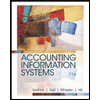
(1)
Financial Accounting Standards Board (FASB): FASB is the organization which creates, develops, and approves accounting standards; and administrates generally accepted accounting principles (GAAP).
To mention: The specific citation for accounting for a change in classification due to change in probable settlement outcome.
(2)
Stock appreciation rights (SARs): Stock appreciation rights are the compensation plans provided in the form of rights to receive cash or shares for the appreciated value (difference between the market price of shares on the exercise date and the market price of shares on the grant date). The choice between the cash or shares would be chosen either by employers or employees.
Debit and credit rules:
- Debit an increase in asset account, increase in expense account, decrease in liability account, and decrease in
stockholders’ equity accounts. - Credit decrease in asset account, increase in revenue account, increase in liability account, and increase in stockholders’ equity accounts.
To journalize: The entry to record the change in the given circumstance
Want to see the full answer?
Check out a sample textbook solution
Chapter 19 Solutions
INTERMEDIATE ACCOUNTING ACCESS 540 DAY
- I need help with this general accounting question using standard accounting techniques.arrow_forwardI am trying to find the accurate solution to this general accounting problem with the correct explanation.arrow_forwardPlease explain the solution to this general accounting problem with accurate explanations.arrow_forward
- Please explain the accurate process for solving this financial accounting question with proper principles.arrow_forwardJackson and Ashley Turner (both 45 years old) are married and want to contribute to a Roth IRA for Ashley. For the current year, their AGI is $236,500. Jackson and Ashley each earned half of the income. How much can Ashley contribute to her Roth IRA if they file a joint return?arrow_forwardI am searching for a clear explanation of this financial accounting problem with valid methods.arrow_forward
- Jimmer has contributed $17,000 to his Roth IRA, and the balance in the account is $20,000. In the current year, Jimmer withdrew $18,800 from the Roth IRA to pay for a new car. If Jimmer's marginal ordinary income tax rate is 23 percent, what amount of tax and penalty, if any, is Jimmer required to pay on the withdrawal in each of the following alternative situations? Jimmer opened the Roth account 44 months before he withdrew the $18,800, and Jimmer is 62 years of age. What is the tax amount?arrow_forwardAlicia has been working for JMM Corporation for 32 years. Alicia participates in JMM's defined benefit plan. Under the plan, for every year of service for JMM, she is to receive 2 percent of the average salary of her three highest consecutive calendar years of compensation from JMM. She retired on January 1, 2024. Before retirement, her annual salary was $588,000, $627,000, and $666,000 for 2021, 2022, and 2023. What is the maximum benefit Alicia can receive in 2024?arrow_forwardABC Manufacturing Company produces widgets and has been operating for several years. The company's management team is responsible for preparing and monitoring the company's budget to ensure that it stays on track and achieves its financial objectives. ABC Manufacturing Company has recently completed its fiscal year. Management has compiled the planning budget and actual results for the year and has found that the company's actual performance fell short of its budgeted expectations. Management wants your help in gleaning extra information from what we have. The budget and actual results are as follows: Planning budget Sales revenue $5,000 Direct materials 1,000 Direct labor 1,500 Manufacturing overhead 750 Selling and administrative expenses 1,500 Profit $250 Actual results Sales revenue $4,500 Direct materials 1,200 Direct labor 1,100 Manufacturing overhead 900…arrow_forward
- You gave me unhelpful so i am also gave you unhelpful.if you will not give unhelpful then also i will not give unhelpful. what is accoun?arrow_forwardKling Company was organized in December Year 1 and began operations on January 2, Year 2. Prior to the start of operations, it incurred the following costs: Costs of hiring new employees Attorney's fees in connection with the organization of the company Improvements to leased offices prior to occupancy (10-year lease) Costs of pre-opening advertising Required: 1. What amount should the company expense in Year 1? 600 $3,000 12,000 6,000 5,000 Chapter 12 Homework assignment take frame Start-Up Costs What amount should the company expense in Year 2? +A $arrow_forwardI needarrow_forward
 Fundamentals Of Financial Management, Concise Edi...FinanceISBN:9781337902571Author:Eugene F. Brigham, Joel F. HoustonPublisher:Cengage Learning
Fundamentals Of Financial Management, Concise Edi...FinanceISBN:9781337902571Author:Eugene F. Brigham, Joel F. HoustonPublisher:Cengage Learning Accounting Information SystemsFinanceISBN:9781337552127Author:Ulric J. Gelinas, Richard B. Dull, Patrick Wheeler, Mary Callahan HillPublisher:Cengage Learning
Accounting Information SystemsFinanceISBN:9781337552127Author:Ulric J. Gelinas, Richard B. Dull, Patrick Wheeler, Mary Callahan HillPublisher:Cengage Learning Cornerstones of Financial AccountingAccountingISBN:9781337690881Author:Jay Rich, Jeff JonesPublisher:Cengage Learning
Cornerstones of Financial AccountingAccountingISBN:9781337690881Author:Jay Rich, Jeff JonesPublisher:Cengage Learning



